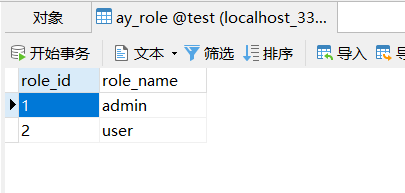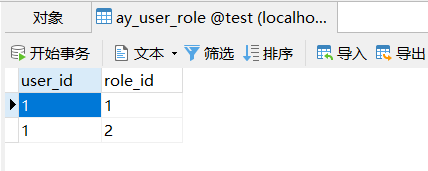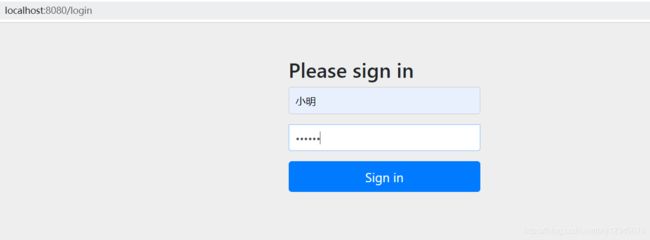springboot 集成spring security(二)
上一章的练习中,用户名和密码都是写在代码里的,这显然是不符合逻辑的。
一、我们需要在数据库中建立角色表ay_role和用户角色关联表ay_user_rdle_rel
二、建立对应的实体类
package com.example.demo.model;
import org.springframework.security.crypto.bcrypt.BCryptPasswordEncoder;
import javax.persistence.Column;
import javax.persistence.Entity;
import javax.persistence.Id;
import javax.persistence.Table;
import java.io.Serializable;
@Entity
@Table(name = "ay_user")
public class AyUser implements Serializable {
final static BCryptPasswordEncoder bcp = new BCryptPasswordEncoder();
@Id
@Column(name = "user_id")
private String id;
@Column(name = "user_name")
private String name;
@Column(name = "user_password")
private String password;
public String getId() {
return id;
}
public void setId(String id) {
this.id = id;
}
public String getName() {
return name;
}
public void setName(String name) {
this.name = name;
}
public String getPassword() {
return password;
}
public void setPassword(String password) {
this.password = bcp.encode(password);
}
}
package com.example.demo.model;
import java.io.Serializable;
/**
* 角色类
*/
public class AyRole implements Serializable {
private String id;
private String name;
public String getId() {
return id;
}
public void setId(String id) {
this.id = id;
}
public String getName() {
return name;
}
public void setName(String name) {
this.name = name;
}
}
package com.example.demo.model;
import java.io.Serializable;
/**
* 用户角色关联类
*/
public class AyUserRole implements Serializable {
private String userId;
private String roleId;
public String getUserId() {
return userId;
}
public void setUserId(String userId) {
this.userId = userId;
}
public String getRoleId() {
return roleId;
}
public void setRoleId(String roleId) {
this.roleId = roleId;
}
}
三、创建对应的xml、dao、service
package com.example.demo.dao;
import com.example.demo.model.AyRole;
import org.apache.ibatis.annotations.Mapper;
import org.apache.ibatis.annotations.Param;
@Mapper
public interface AyRoleDao {
/**
*根据id查询
*/
AyRole findById(@Param("roleId") String id);
}
package com.example.demo.service;
import com.example.demo.dao.AyRoleDao;
import com.example.demo.model.AyRole;
import org.springframework.stereotype.Service;
import javax.annotation.Resource;
@Service
public class AyRoleService {
@Resource
private AyRoleDao ayRoleDao;
public AyRole findById(String id)
{
return ayRoleDao.findById(id);
}
}
package com.example.demo.dao;
import com.example.demo.model.AyUserRole;
import org.apache.ibatis.annotations.Mapper;
import java.util.List;
@Mapper
public interface AyUserRoleDao {
List findByUserId(String userId);
}
package com.example.demo.service;
import com.example.demo.dao.AyUserRoleDao;
import com.example.demo.model.AyUserRole;
import org.springframework.stereotype.Service;
import javax.annotation.Resource;
import java.util.List;
@Service
public class AyUserRoleService {
@Resource
private AyUserRoleDao ayUserRoleDao;
public List findByUserId(String id)
{
return ayUserRoleDao.findByUserId(id);
}
}
四、自定义用户服务类和权限配置类,这一步是核心
package com.example.common.security;
import com.example.common.error.BussinessException;
import com.example.demo.model.AyRole;
import com.example.demo.model.AyUser;
import com.example.demo.model.AyUserRole;
import com.example.demo.service.AyRoleService;
import com.example.demo.service.AyUserRoleService;
import com.example.demo.service.AyUserService;
import org.springframework.security.core.GrantedAuthority;
import org.springframework.security.core.authority.SimpleGrantedAuthority;
import org.springframework.security.core.userdetails.User;
import org.springframework.security.core.userdetails.UserDetails;
import org.springframework.security.core.userdetails.UserDetailsService;
import org.springframework.security.core.userdetails.UsernameNotFoundException;
import org.springframework.stereotype.Service;
import javax.annotation.Resource;
import java.util.ArrayList;
import java.util.List;
/**
* UserDetailsService接口是spring security框架提供的
* CustomUserService实现loadUserByUsername方法,用来加载用户的角色,并将角色放入一个集合
* 最后把用户名,密码和角色放入User对象
*/
@Service
public class CustomUserService implements UserDetailsService {
@Resource
private AyUserService ayUserService;
@Resource
private AyRoleService ayRoleService;
@Resource
private AyUserRoleService ayUserRoleService;
@Override
public UserDetails loadUserByUsername(String name) throws UsernameNotFoundException {
List byName = ayUserService.findByName(name);
AyUser ayUser = byName.get(0);
if (ayUser == null) {
throw new BussinessException("用户不存在");
}
//获取用户所有的角色
List ayUserRoleList = ayUserRoleService.findByUserId(ayUser.getId());
List authList = new ArrayList<>();
if (authList != null && ayUserRoleList.size() > 0) {
for (AyUserRole ayUserRole : ayUserRoleList) {
//获取用户关联角色名称
String roleName = ayRoleService.findById(ayUserRole.getRoleId()).getName();
authList.add(new SimpleGrantedAuthority(roleName));
}
}
return new User(ayUser.getName(),ayUser.getPassword(),authList);
}
}
package com.example.common.security;
import org.springframework.beans.factory.annotation.Autowired;
import org.springframework.context.annotation.Bean;
import org.springframework.context.annotation.Configuration;
import org.springframework.security.config.annotation.authentication.builders.AuthenticationManagerBuilder;
import org.springframework.security.config.annotation.web.builders.HttpSecurity;
import org.springframework.security.config.annotation.web.builders.WebSecurity;
import org.springframework.security.config.annotation.web.configuration.EnableWebSecurity;
import org.springframework.security.config.annotation.web.configuration.WebSecurityConfigurerAdapter;
import org.springframework.security.crypto.bcrypt.BCryptPasswordEncoder;
import org.springframework.security.crypto.password.PasswordEncoder;
/**
* security配置类
*/
@Configuration
@EnableWebSecurity //开启Security安全框架
public class WebSecurityConfig extends WebSecurityConfigurerAdapter {
@Bean
public PasswordEncoder passwordEncoder() {
return new BCryptPasswordEncoder();
}
@Bean
public CustomUserService customUserService()
{
return new CustomUserService();
}
/**
* 访问权限的简单配置
* 重写configure帆帆,通过formLogin方法配置启用默认页面
* 通过failureUrl方法配置登陆失败返回的URL
* 通过defaultSuccessUrl配置登陆成功的URL
* 通过permitAll方法设置登陆页面全部权限可以访问
* @param http
* @throws Exception
*/
@Override
protected void configure(HttpSecurity http) throws Exception
{
http
.formLogin() //启用默认登陆页面
.failureUrl("/login?error") //登陆失败的URL: /login?error
.defaultSuccessUrl("/ayUser/test") //登陆成功的URL
.permitAll();
super.configure(http);
}
/**
* 配置内存用户
* AuthenticationManagerBuilder类的方法inMemoryAuthentication可添加内存中的用户
* 并可给用户指定角色权限
* Security5默认要求密码使用加密,不加密的话就使用"{noop}123456"这样的写法,加密的话需要使用
* PasswordEncoder的实现类进行加密
* @param auth
* @throws Exception
*/
@Autowired
public void configureGlobal(AuthenticationManagerBuilder auth) throws Exception
{
auth
.userDetailsService(customUserService()).passwordEncoder(new BCryptPasswordEncoder());
// .inMemoryAuthentication()
// .withUser("小明").password("{noop}123456").roles("ADMIN")
// .and()
// .withUser("小花").password("{noop}123456").roles("USER");
}
/**
* 如果使用springboot默认的静态资源路径,将不会生效
* 必须在application.properties里面自定义静态资源路径之后才生效
* spring.resources.static-locations=classpath:/static
* spring.mvc.static-path-pattern=/static/**
* @param web
* @throws Exception
*/
@Override
public void configure(WebSecurity web) throws Exception {
//设置静态资源不要拦截
web.ignoring().antMatchers("/static/**");
}
}spring security在用户登陆时用BCrypt加密方式对用户密码进行处理。如果你用的是在数据库中存储用户名和密码,那么一般是要在用户注册时就使用BCrypt编码将用户密码加密处理后存储在数据库中。并且修改configure()方法,入".passwordEncoder(new BCryptPasswordEncoder())",保证用户登录时使用bcrypt对密码进行处理再与数据库中的密码比对,
所以我们保存用户密码时就对密码进行BCrypt加密
package com.example.demo.model;
import org.springframework.security.crypto.bcrypt.BCryptPasswordEncoder;
import javax.persistence.Column;
import javax.persistence.Entity;
import javax.persistence.Id;
import javax.persistence.Table;
import java.io.Serializable;
@Entity
@Table(name = "ay_user")
public class AyUser implements Serializable {
final static BCryptPasswordEncoder bcp = new BCryptPasswordEncoder();
@Id
@Column(name = "user_id")
private String id;
@Column(name = "user_name")
private String name;
@Column(name = "user_password")
private String password;
public String getId() {
return id;
}
public void setId(String id) {
this.id = id;
}
public String getName() {
return name;
}
public void setName(String name) {
this.name = name;
}
public String getPassword() {
return password;
}
public void setPassword(String password) {
this.password = bcp.encode(password);
}
}
五、我们开始测试
首先我们加入两个用户
再加入两个角色
给用户分配角色
我们开始登陆,
登陆成功
当我们想关闭springboot security验证时
@Override
public void configure(WebSecurity web) throws Exception {
// TODO 关闭spring security
web.ignoring().antMatchers("/**");
}








